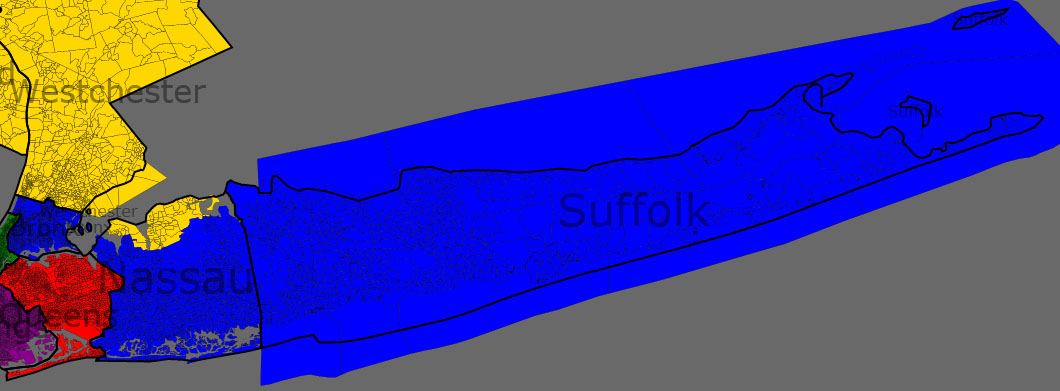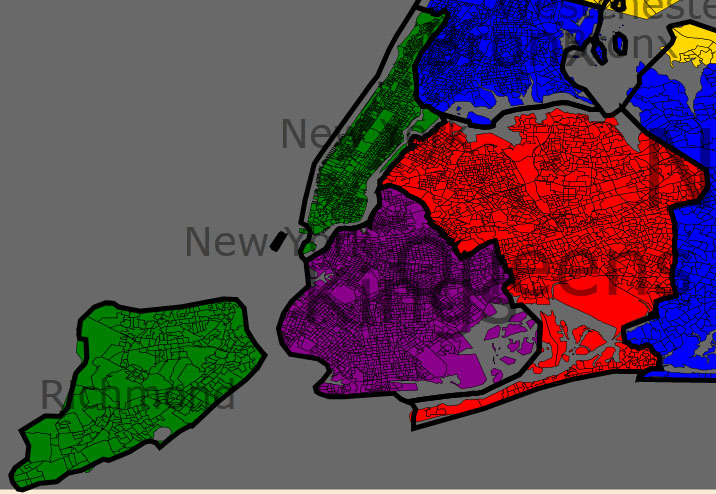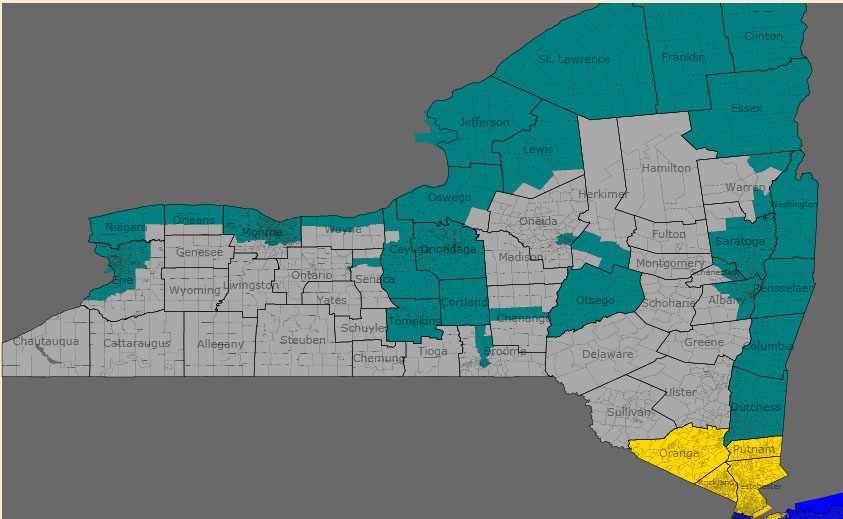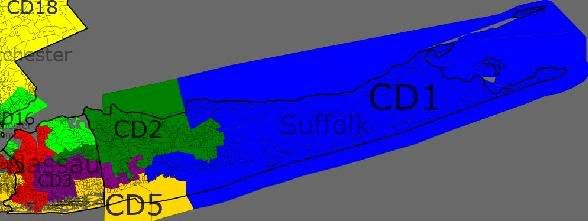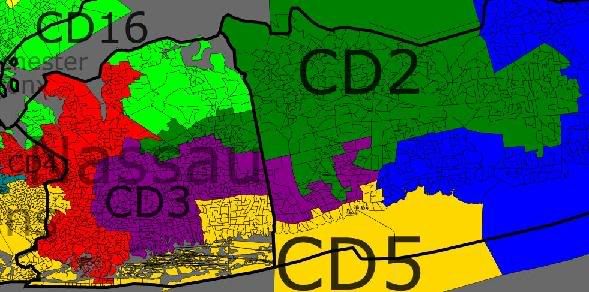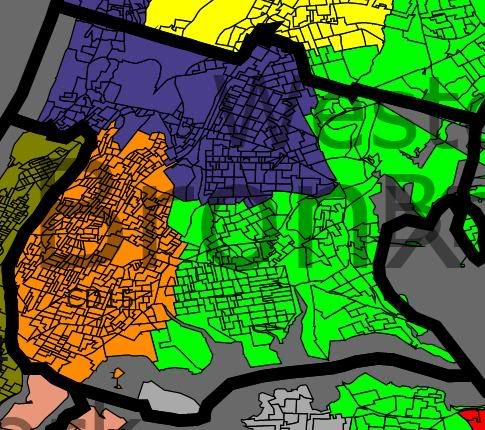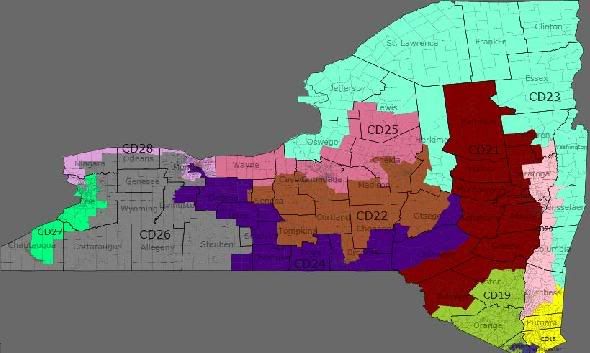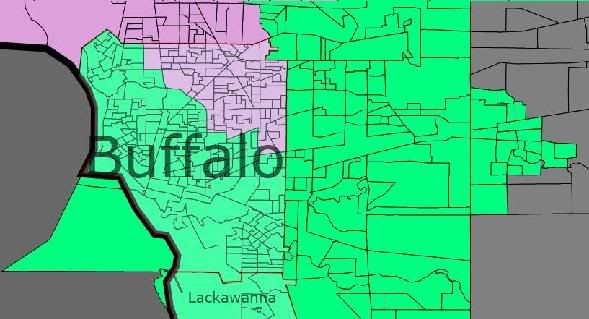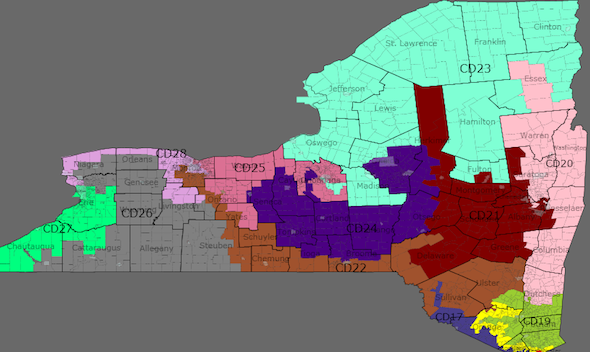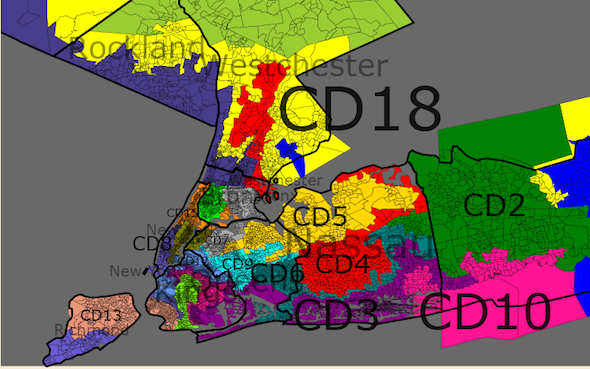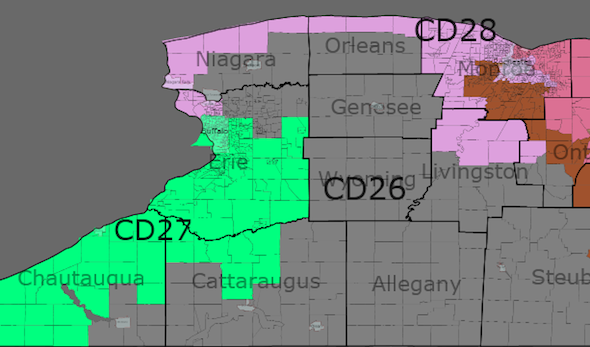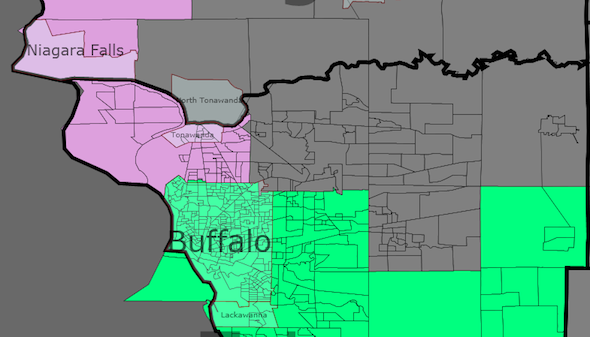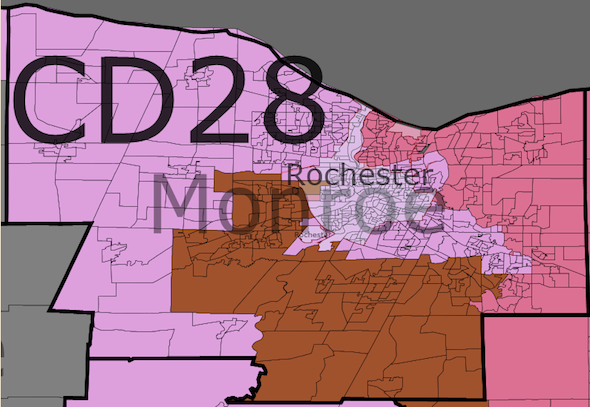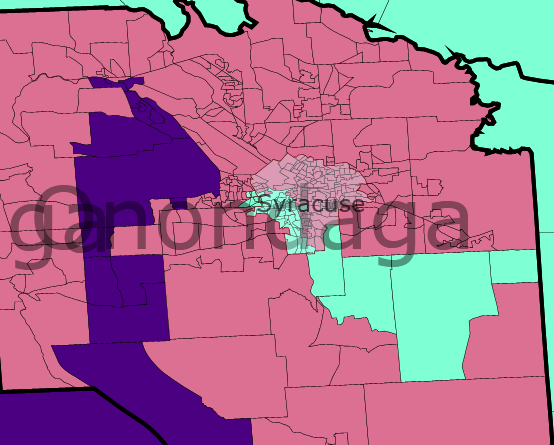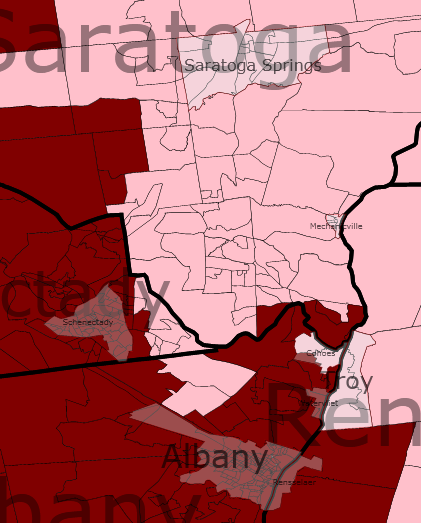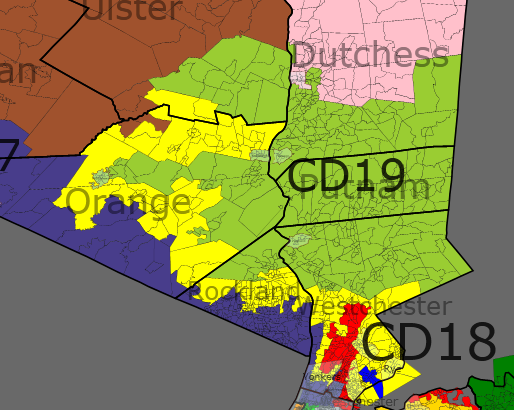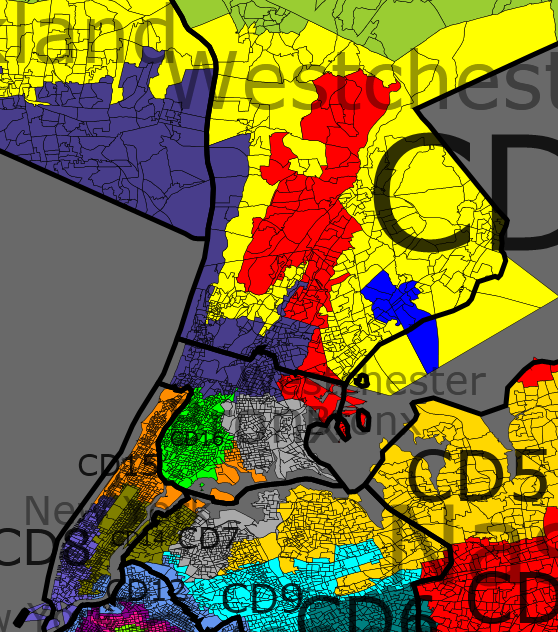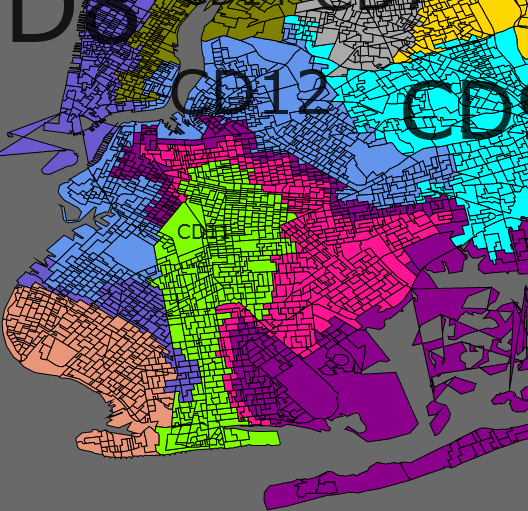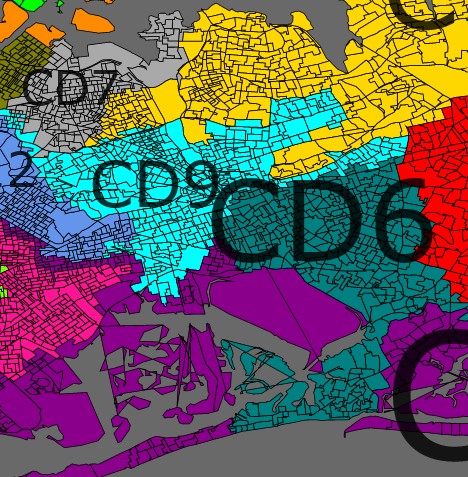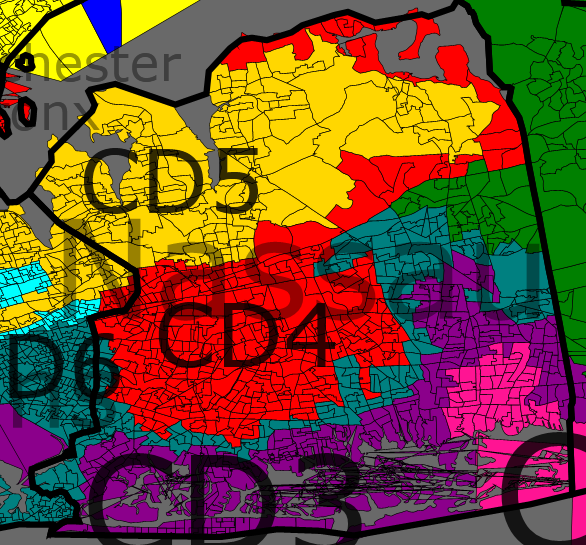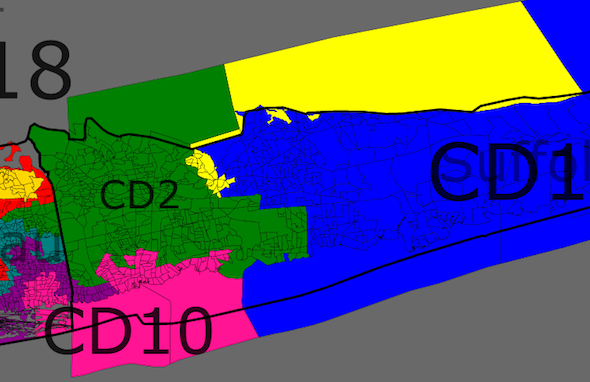This is my contest entry for Redistricting New York.
The aim of this entry was to create a map where 27 Democrats should be expected to win in New York in any given election. Every Democratic district is 53%+ for Obama. (Notwithstanding the astute observation by jeffmd that Presidential toplines don't mean everything) only 16 Republicans were elected in districts that Obama won by 53% or more (DE-AL, IL-06, IL-10, IL-13, IL-16, IA-04, LA-02, MI-06, MI-08, MI-11, NJ-02, OH-12, PA-06, PA-15, VA-10, and WA-08 [55% or more in bold]).
This entry respects VRA districts in New York City, puts King an a solid Obama district, and solidifies Democratic districts in upstate New York.
Since New York is expected to lose one Congressional seat, one incumbent's district needs to be eliminated. Although the current Representative from New York 23 is a Democrat, I eliminated Representative Owens district and combined his home with Representative Murphy's NY-20. This map also shifts Representative Massa out of his district (represented here as NY-19). The reason for this is the location of his home in southeastern Steuben County. Steuben County is surrounded by Republican leaning counties, and a way to create a third solid Democratic district in Western New York is to connect Rochester and Syracuse.


Long Island
NY 1 Current Incumbent – Bishop
Population – 700,226
|
White |
Black |
Asian |
Hispanic |
| Race |
77% |
7% |
2% |
12% |
|
Obama |
McCain |
| Old District |
54% |
44% |
| New District |
54% |
46% |
| Change |
0% |
+2% |
NY 1 becomes the southern half of Suffolk County.
NY 2 – Current Incumbent – Israel
Population – 700,711
|
White |
Black |
Asian |
Hispanic |
| Race |
78% |
7% |
3% |
10% |
|
Obama |
McCain |
| Old District |
56% |
43% |
| New District |
54% |
46% |
| Change |
-2% |
+3% |
NY 2 contains the central and northeastern portions of Suffolk County. This district remains potentially competitive, as the district vote for Obama was 53%.
Of all of the districts drawn on this map, this is probably the hardest one to justify – going from a district where Obama won with 56% in 2008. The only solace that I have is that a) Republicans rarely win districts where Obama won with 53% or greater, and b) there are plenty of Republican precincts in Nassau in Suffolk counties, especially along the border and along the northern shore. This, then requires a couple of decisions that need to be made. First, you could divide up Nassau and Suffolk counties east-west as exemplified by Answer Guy with a historical discussion here. Answer Guy's map divides Nassau into seven districts – each taking a portion of the Republican areas on Long Island.
NY 3 – Current Incumbent – None
Population – 700,454
|
White |
Black |
Asian |
Hispanic |
| Race |
70% |
13% |
4% |
11% |
|
Obama |
McCain |
| Old District |
47% |
52% |
| New District |
55% |
44% |
| Change |
+8% |
-8% |
Unlike other maps for this contest, I did not feel the need to split up Long Island – just moving the pieces around could create four Democratic-leaning districts (and BTW, and FWIW, WA 1 is connected by Ferry between Edmonds and Kingston).
This configuration of NY 3 draws Representative King out of the district. Even if he were to decide to run in the district, and not against Representative McCarthy in his NY 4, he would face a district where Obama received 55% of the vote.
The district is split into two areas, those parts of Hempstead adjacent to Queens and the portion of Hempstead adjacent to Suffolk County. The two areas are connected through Long Beach.
NY 4 – Current Incumbent – McCarthy
Population – 700,121
|
White |
Black |
Asian |
Hispanic |
| Race |
77% |
5% |
9% |
9% |
|
Obama |
McCain |
| Old District |
58% |
41% |
| New District |
54% |
46% |
| Change |
-4% |
5% |

This is perhaps my ugliest looking district, but Representative McCarthy should be able to retain his seat under this configuration. The district encompasses the northern part of Nassau County, some Republican areas of Hempstead, and the North and West portions of Suffolk County. The district also extends into the Bay Side and Bay Terrace neighborhoods of the Queens.
If Representative King were to run for this seat, he would find its dynamics very unfavorable, with a lot of new constituents with a strong Democratic lean.
NY 5 – Current Incumbent – Ackerman/King
Population – 700,231
|
White |
Black |
Asian |
Hispanic |
| Race |
54% |
9% |
20% |
14% |
|
Obama |
McCain |
| Old District |
63% |
36% |
| New District |
60% |
39% |
| Change |
-3% |
+3% |
NY 5 could be considered a New York City district, as it stretches from the Bronx through Queens into North Hempstead and Republican areas of Hempstead (including Representative King's Seaford neighborhood).
New York City
NY 6 Current Incumbent – Meeks
Population – 700,218
|
White |
Black |
Asian |
Hispanic |
| Race |
16% |
51% |
8% |
16% |
|
Obama |
McCain |
| Old District |
89% |
11% |
| New District |
86% |
13% |
| Change |
-3% |
+2% |
This is a VRA district, and it does not change much from the current district. It does add all of the Rockaways.
NY 7 Current Incumbent – Crowley
Population – 700,095
|
White |
Black |
Asian |
Hispanic |
| Race |
41% |
9% |
11% |
34% |
|
Obama |
McCain |
| Old District |
79% |
20% |
| New District |
70% |
29% |
| Change |
-9% |
+9% |
Like the existing district, there are two distinct areas of the district. Instead of going North, NY 7 now orientates South, from Woodside and Hunters Point, through Ridgewood and Bushwick, and Woodhaven. From there, the district cuts into Jamaca Bay, Floyd Bennet Field and Marine Park to connect to Seagate, Coney Island, Brighton Beach and Manhattan Beach.
This is a minority-majority district.
NY 8 Current Incumbent – Nadler
Population – 700,295
|
White |
Black |
Asian |
Hispanic |
| Race |
52% |
11% |
15% |
20% |
|
Obama |
McCain |
| Old District |
74% |
25% |
| New District |
87% |
13% |
| Change |
+13% |
-12% |
NY 8 is now entirely a West Side/Lower Manhattan district.
NY 9 Current Incumbent – Weiner
Population – 700,395
|
White |
Black |
Asian |
Hispanic |
| Race |
26% |
11% |
17% |
42% |
|
Obama |
McCain |
| Old District |
55% |
44% |
| New District |
76% |
23% |
| Change |
+21% |
-21% |
NY 9 takes what was lost from NY 7 – crossing from the Queens into the Bronx over the Bronx-Whiteshone Bridge. The district is a minority-majority district.
NY 10 Current Incumbent – Towns
Population – 700,417
|
White |
Black |
Asian |
Hispanic |
| Race |
24% |
52% |
4% |
16% |
|
Obama |
McCain |
| Old District |
91% |
9% |
| New District |
84% |
16% |
| Change |
-7% |
+7% |

NY 10 loses the Willamsburg neighborhood and areas toward the west, and gains Republican areas in Manhattan Terrace. The district remains an African-American majority district.
NY 11 Current Incumbent – Clarke
Population – 700,102
|
White |
Black |
Asian |
Hispanic |
| Race |
49% |
15% |
16% |
16% |
|
Obama |
McCain |
| Old District |
90% |
9% |
| New District |
60% |
40% |
| Change |
-30% |
+31% |
The district extends from Representative Clarke's home precinct in Prospect Gardens in the north to Bath Beach in the south. While NY 11 is no longer an African-American majority district, it remains a minority-majority district. Because it takes in many of the Republican precincts in Queens, Obama's percentage in the district drops to 60%.
NY 12 Current Incumbent – Velazquez
Population – 700,391
|
White |
Black |
Asian |
Hispanic |
| Race |
22% |
50% |
4% |
20% |
|
Obama |
McCain |
| Old District |
86% |
13% |
| New District |
91% |
9% |
| Change |
+5% |
-4% |
NY 12 is now the second African-American majority district located entirely in the Queens. The district encompasses the Crown Heights and Prospect Heights neighborhoods as well as the Williamsburg neighborhoods. On the western edge of the Queens, a finger stretches south to pick up Representative Velazquez's home precinct in Carroll Gardens.
It is possible that neither Nydia Velazquez nor Yvette Clarke would be happy in their districts, since Representative Clarke will represent the more Hispanic-leaning district, while Representative Velazquez will represent an African-American majority district. However, this could be easily rectified. First, in my original map (before I learned what precinct each representative lives in), I had Representative Clarke in NY 12 (and she now is the Northernmost precinct of NY 11). Second, since Representative Velazquez is a renter, it is possible that she could subsequently move into the then open NY 11.
NY 13 Current Incumbent – McMahon
Population – 700,091
|
White |
Black |
Asian |
Hispanic |
| Race |
67% |
9% |
6% |
15% |
|
Obama |
McCain |
| Old District |
49% |
51% |
| New District |
60% |
39% |
| Change |
+11% |
-12% |
All of Staten Island remains in NY 13, and the district crosses into Brooklyn over the Verrazano-Narrows Bridge. From the bridge, the district heads north along the New York Bay into the Red Hook and Gowanus neighborhoods.
This composition makes the swing district a reliable Democratic district. Obama won 60% in this district.
NY 14 Current Incumbent – Maloney
Population – 700,256
|
White |
Black |
Asian |
Hispanic |
| Race |
61% |
8% |
9% |
19% |
|
Obama |
McCain |
| Old District |
78% |
21% |
| New District |
80% |
19% |
| Change |
+2% |
-2% |
NY 14 retains much of its current shape – although it does go a bit further north to encompass Rikers Island. Representative Maloney should be happy, as Obama won 80% of the vote here.
NY 15 Current Incumbent – Rangel
Population – 699,954
|
White |
Black |
Asian |
Hispanic |
| Race |
14% |
30% |
3% |
50% |
|
Obama |
McCain |
| Old District |
93% |
6% |
| New District |
91% |
8% |
| Change |
-2% |
+2% |

Charlie Rangel may face a stiff primary challenge in this district where Obama won 91% of the vote. The district loses portions of the Upper West Side for the Norwood and Olinville neighborhoods in the Bronx. The district does retain most of Harlem.
The district is a majority Hispanic district (just over 50%).
NY 16 Current Incumbent – Serrano
Population – 700,580
|
White |
Black |
Asian |
Hispanic |
| Race |
5% |
30% |
2% |
60% |
|
Obama |
McCain |
| Old District |
95% |
5% |
| New District |
93% |
6% |
| Change |
-2% |
+1% |
60% Hispanic. 93% Obama. Not much more I can say about this Bronx district.
Upstate New York
NY 17 Current Incumbent – Lowey
Population – 700,687
|
White |
Black |
Asian |
Hispanic |
| Race |
62% |
20% |
3% |
12% |
|
Obama |
McCain |
| Old District |
62% |
38% |
| New District |
62% |
37% |
| Change |
+0% |
-1% |
Representative Lowey's district extends from the Bronx and follows I-95 and I-695 through Mount Vernon to the Connecticut border. To complete the district, NY 17 extends north along I-84 into eastern Putnam County and southern Dutchess counties.
NY 18 Current Incumbent – Engel
Population – 700,238
|
White |
Black |
Asian |
Hispanic |
| Race |
70% |
9% |
5% |
14% |
|
Obama |
McCain |
| Old District |
72% |
28% |
| New District |
58% |
41% |
| Change |
-14% |
+13% |
New York 18 extends into the Bronx to pick up Representative Engel's neighborhood of Fairport goes north through Yonkers into Westchester and Putnam counties. The District crosses the Hudson over I-87, and takes the Republican portions of Rockland and Orange County.
Engel's district takes a hit in order to strengthen Representative Hall. Obama's percentage in the district drops to 58%, which still should be a safe seat for a Democrat.
NY 19 Current Incumbent – None
Population – 700,409
|
White |
Black |
Asian |
Hispanic |
| Race |
86% |
6% |
2% |
3% |
|
Obama |
McCain |
| Old District* |
56% |
43% |
| New District |
56% |
43% |
| Change |
+0% |
-0% |
* Percentage for Representative Maffei's current district
Percentage for NY 29 = Obama 48%, McCain 50%
This configuration of upstate New York is necessary to preserve a 27-1 delegation. With Eric Massa's home in Corning in Southeastern Steuben County, the possible routes are to go north to Rochester, north and east to Ithica and Syracuse, or west towards Buffalo. None of these options make much sense and damage the possibilities of creating a Democratic performing district for Representative Arcuri's Utica based district because of the need to add population to NY 22 (or Maffei's Syracuse based district).
1) North to Rochester/Syracuse. This route is problematic for the creation of a sensible (to the eye) district for Representative Arcuri. Since in this formulation, his district spans I-90 and dives south to pick up Ithaca, any finger north puts pressure on Arcuri's district to ensure contiguity. (Also see MattTX2's entry for a good explanation of why going North does not work).
2) West to Buffalo. This route is more logical than going North, but has the effect of making NY 26 an eyesore, when it is possible to create a compact Republican performing district in Western New York and safer Democratic districts throughout upstate New York.
Instead, what I did was to create a district spanning I-90 from Syracuse to Rochester and Democratic portions of Ontario county, which is similar to the existing NY 25. In this district, Obama received 55% of the vote. As I suggested in the intro, 55% is really the safest magic number, with 7 Republicans representing districts 55% plus. Of those 7 Republicans, one Cao won because of scandal, two are in Illinois (where Obama is from), and one is a state institution (Castle). For me, the only head scratchers are the two Pennsylvania districts and WA-8 (but that is a different story).
To sum up, NY-19 is a very safe Democratic district and follows much of the current NY 25, even if it does not contain Representative Massa's (or Representative Maffei's) current residence. This does not pose a Constitutional problem, but long-term, is a relatively compact district that should safely elect a Democrat to Congress. In addition, if Massa is not able to win reelection in 2010 (rated lean Democrat by CQ; Kerry 42%, Gore 43%), the issue then becomes moot. However, since that is not part of the conditions of this contest, I choose to create a compact district between Rochester and Syracuse and elsewhere in upstate New York that are more consistently Democratic performing.
NY 20 Current Incumbent – Hall
Population – 700,079
|
White |
Black |
Asian |
Hispanic |
| Race |
74% |
10% |
3% |
12% |
|
Obama |
McCain |
| Old District |
51% |
48% |
| New District |
55% |
44% |
| Change |
+4% |
-4% |

Representative Hall's district, like most of the swing districts in upstate New York is strengthened. The district stretches from the northern portion of Weschester County (including Yorktown and New Castle) to a small portion of Ulster County and includes the Democratic parts of Rockland County and Orange County.
The district becomes a safe seat for Representative Hall, with Obama's percentage at 55%.
As an aside, I think this district looks like a M.U.S.C.L.E. Man, with its head in Ulster County, two arms going from Orange County to Dutchess County, and its two legs stretching into Ramapo and Yorktown and New Castle.
NY 21 Current Incumbent – Tonko
Population – 700,765
|
White |
Black |
Asian |
Hispanic |
| Race |
89% |
6% |
2% |
3% |
|
Obama |
McCain |
| Old District |
58% |
40% |
| New District |
56% |
42% |
| Change |
+2% |
-2% |

This Albany-centered district becomes less Democratic to shore up Representative Arcuri's seat, but the district should remain a safe seat for Representative Tonko.
In the Capitol Region area, the district loses Schenectady and gains Saratoga. Outside of the region, the district takes in Republican-leaning portions of Schohare and Greene counties, and Republican areas of Delaware and Ostego counties. Representative Tonko's residence in Amsterdam remains in the district.
NY 22 Current Incumbent – Hinchey/Massa
Population – 700,478
|
White |
Black |
Asian |
Hispanic |
| Race |
88% |
5% |
2% |
4% |
|
Obama |
McCain |
| Old District |
59% |
39% |
| New District |
55% |
44% |
| Change |
-4% |
+5% |
This district is drawn for Represenative Hinchey, but would be a good district for Representative Massa should Hinchey (72) retire.
The district stretches along the Southern border of New York from Hinchey's home town of Hurley to Corning in Steuben County. The district also encompasses the Southern portions of Tompkins and Cortland counties and, in the East, the City of Poughkeepsie. The performance of the district does drop to 55% – staying above the potentially competitive line.
NY 23 Current Incumbent – Murphy/Owens
Population – 700,469
|
White |
Black |
Asian |
Hispanic |
| Race |
93% |
3% |
1% |
2% |
|
Obama |
McCain |
| Old District |
51% |
48% |
| New District |
53% |
45% |
| Change |
+2% |
-3% |
New York 23 takes in many of the counties in the Adirondack Mountains in upstate New York and then follows the Vermont/Massachusetts border into Dutchess County.
This district contains most of the current NY 20 and portions of the current NY 23 and 24, but still raises Obama's percentage from 51% to 53%. Most of the increase is due to losing Greene and Delaware counties, in favor of more reliable Democratic Franklin and Clinton counties in the North.
Both Murphy and Owens reside in this district, but this is necessary to create safer districts across the State.
NY 24 Current Incumbent – Maffei
Population – 700,386
|
White |
Black |
Asian |
Hispanic |
| Race |
91% |
4% |
1% |
2% |
|
Obama |
McCain |
| Old District* |
52% |
47% |
| New District |
55% |
43% |
| Change |
+3% |
-4% |
* Percentage is for the current NY 23
Percentage for the current NY 25: 56% Obama, 43% McCain

Instead of going east from Syracuse, as Maffei's current district does, this district goes North, picking up large portions of the current NY 23 (Oswego, Lewis, Jefferson, and St Lawrence Counties). This district is Syracuse based, both in population and possess a shared community of interest, with most of the district in the Syracuse TV market (or Watertown market, which overlaps with Syracuse anyway).
This configuration does suggest a swing, but increasingly Democratic district. Obama did get 55% in 2008, but it may have barely gone for Bush in 2004. Perot did well in this district in 92, probably getting close to 25-26% of the vote (compared to 16% in New York and 19% nationwide).
NY 25 Current Incumbent – Arcuri
Population – 700,483
|
White |
Black |
Asian |
Hispanic |
| Race |
87% |
7% |
2% |
3% |
|
Obama |
McCain |
| Old District |
50% |
48% |
| New District |
54% |
44% |
| Change |
+4% |
-4% |

District 25 becomes an octopus looking district that stretches from Democratic Schenectady to Democratic Syracuse and Ithaca in the east. The head of the octopus is Representative Arcuri's home county of Oneida. The district also picks up portions of Syracuse. Despite the uglish looking nature of the district, the district gains 4% for Obama from 2008.
The district contains all of Schenectady, Oneida, and Madison counties, as well as portions of Montgomery, Schoharie, Otsego, Cortland, Tompkins, and Canondaga counties.
NY 26 Current Incumbent – Lee
Population – 699,996
|
White |
Black |
Asian |
Hispanic |
| Race |
94% |
2% |
1% |
1% |
|
Obama |
McCain |
| Old District |
46% |
52% |
| New District |
44% |
55% |
| Change |
-2% |
+3% |
With this map, Representative Lee is the safest Republican in any of the New England states. This NY 26 takes in his home precinct of Clarence 22 in Erie County, and encompasses most of the Republican leaning counties in Western NY as well as Republican-leaning areas in Western Monroe county. The district is comprised of all of Genessee, Wyoming, Livingston, Yates, Schuyler, Allegany, Cattaraugus, and Chautauqua counties, most of Stuben and the Republican areas of Ontario counties.
NY 27 Current Incumbent – Higgens
Population – 700,487
|
White |
Black |
Asian |
Hispanic |
| Race |
81% |
14% |
2% |
2% |
|
Obama |
McCain |
| Old District |
54% |
44% |
| New District |
57% |
41% |
| Change |
+3% |
-3% |

In creating a Republican performing district for Lee, NY 27 is the most immediate beneficiary. NY 27 now is an entirely Erie County district, with the exception of the town of Newstead and parts of Clarence in the Northeast corner (NY 26) and the North and West portions of Buffalo (NY 28).
NY 28 Current Incumbent – Slaughter
Population – 699,977
|
White |
Black |
Asian |
Hispanic |
| Race |
79% |
12% |
1% |
6% |
|
Obama |
McCain |
| Old District |
68% |
30% |
| New District |
57% |
41% |
| Change |
-11% |
+12% |

Representative Slaugher's district stays similar in form to her existing district, but includes all of Niagara and Ontario counties and a large portion of Monroe County. The district does include most of Rochester. The Obama performance in the district drops, from 68% to 57%, but a Democrat should remain safe here.
Conclusion
I am proud of the map. Although not every Democratic incumbent may like the map, at least 24 of the 27 current Democratic incumbents will be very safe in every single election. Of the Democratic incumbents, every district gave Obama at least 53% of the vote. The only remaining potential swing districts are NY 1, NY 2, NY 4, NY 23, and NY 25. Of these districts, NY 23 and NY 25 are significantly safer than before, while NY 1, NY 2, and NY 4 are in Democratic leaning areas of Long Island (NY 4 has a significant presence in New York City as well).
I believe that preserving County and City lines are important to the districting process. Communities of interest should not be broken up whenever possible, and I tried to keep towns intact, especially in upstate New York.
To supporters of Representative Massa, I expect that he will succeed Representative Hinchey when he retires.

Loading ...
